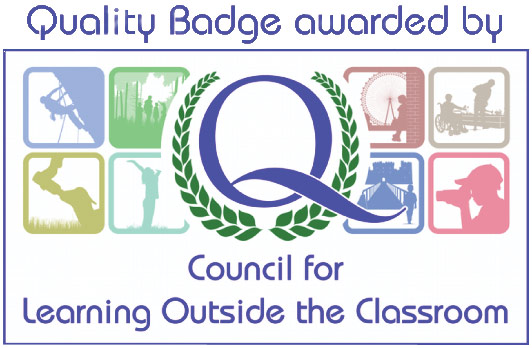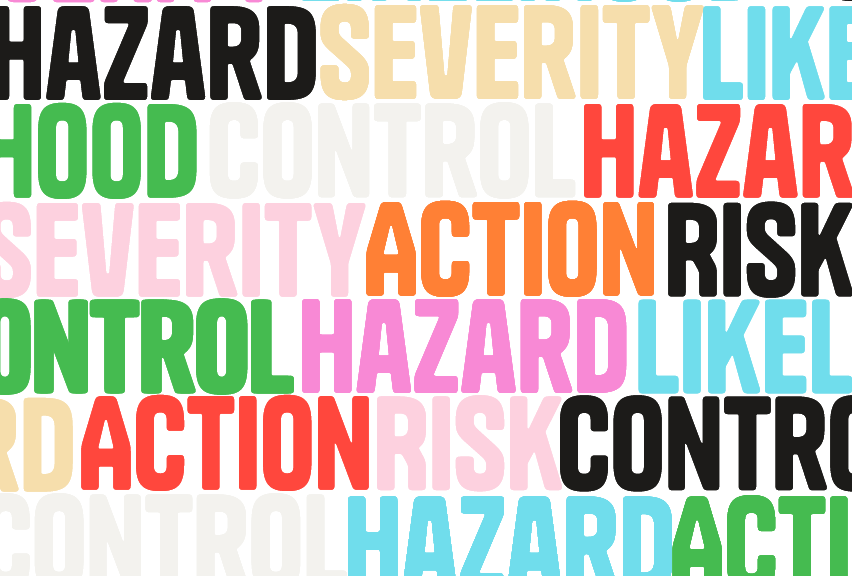If you’re planning a school trip abroad, you’ll definitely need to do a risk assessment. We can’t do it for you (unfortunately), but we can guide you through the process.
What is a risk assessment?

In the context of school travel, a risk assessment is consistent with a group management plan.
In other words, it’s a written plan outlining how the group leader expects to lead their group on the trip, with the objective of returning home safely.
There are loads of different types of risk assessment, but they all essentially boil down to the following process:
- Identifying a hazard
- Recognising that someone is at risk of that hazard
- Making a judgment on how likely it is that the hazard will cause harm, and how much
- Putting control measures in place to minimise the risk
Before you start your risk assessment, make sure you check out the ‘Generic Risk Assessments for School Educational Visits’ and ‘Demystifying Risk Assessments’ guides.
The ‘Demystifying Risk Assessments’ guide will explain in more detail what you need to do.
And the ‘Generic Risk Assessments for School Educational Visits’ gives you some examples and a framework to get you started.
What should a risk assessment include?

It’s really important to follow the guidelines for your particular school and Local Education Authority (LEA) – these will tell you exactly what your risk assessment needs to include.
But, basically, you just need to show that you’ve done your due diligence. You aren’t required to demonstrate an ability to see into the future.
Pro tip: When assessing visits, don’t get hung up on the fact that you’re assessing the Eiffel Tower (because that’s just going to overwhelm you). Boil it down to its essence – a monument that’s open to the public, draws crowds and is tall with lots of stairs.
Now you’ve simplified it, you can see that the Eiffel Tower really poses similar hazards to other public monuments, including kids getting lost, trips on stairs and petty theft.
And, as similar visits are going to pose similar risks, you can save this work as part of a Generic Risk Assessment, which can form the building blocks of future risk assessments.
Even the seemingly most complicated visits and activities can be broken down into building blocks that you can approach in this way, making identifying hazards (almost) a breeze.
And the good news is that once a framework’s been developed, you can use it to speed up the risk assessment process next time.
You’ll need to concentrate on the most significant hazards posed. No one expects you to consider all the insignificant hazards (that’d be a second full-time job). Just as professional judgment is sufficient to deal with situations within a school, the same is true for off-site visits.
However, you will need to consider some of the obvious ‘what ifs’ and have some ‘plan Bs’ in place. For example, could a visit be affected by the weather? If it is, what will you do instead? And what about if a kid gets sick or is injured? How will you make sure they’re looked after (and how could that affect the rest of your group)?
It’s worthwhile checking both your school's or LEA’s emergency procedure and your tour operator’s emergency procedure to make sure they work together – that’s your ultimate ‘plan B’.
And remember, things don’t always happen as we expect them to, so you’re possibly going to need to make some on-the-spot decisions.
For most situations, the same group management skills you use in school are perfectly suitable for off-site visits and, therefore, are totally manageable for you and your colleagues. But you may need to seek expert help or advice in some situations, like a local instructor or guide (just let us know if this is the case).
It’s best practice to have a quick chat with your colleagues at the start of each day about plans and any possible changes that might happen.
It’s a great idea to take a couple of minutes at the end of the day to just jot down any changes or decisions that have to be made on the management plan, so you can reflect on this and use it to guide your next management plan.
And, when you get back to school after the trip, make sure you take some time to debrief with your colleagues and reflect on the planning process and risk assessments – you’ll be pleased you did when it comes to putting together your next group management plan.
Risk assessment templates and examples
Generic risk assessment for all educational visits
This generic risk assessment for school use identifies the common hazards and control measures associated with this type of visit or activity. Before undertaking the activity, schools must also make an assessment of any specific risks associated with their particular visit, including travel, sites, activities and the group of pupils.
| Hazard | Risk | Persons At Risk | Control Measures | Comments/Actions | Residual Risk Rating |
|---|---|---|---|---|---|
| Exposure to weather | Cold injury, heat injury, overexposure to sun | Pupils, staff | • Consider possible weather conditions and plan appropriate programme, clothing and equipment (warm and waterproof clothing and, in summer, sun protection) • Plan for pupils who may/may not bring suitable kit – check before departure and/or bring spares • Daily weather forecast obtained and plans adjusted accordingly |
Provide clear information regarding suitable clothing and equipment to pupils and parents | Low |
| Pupil lost or separated from group, inadequate supervision | Injury, death | Pupils | • Ensure supervising staff are competent and understand their roles • Ratios in line with LEA policy • Plan and use suitable group control measures (e.g. buddy systems, large groups split into small groups each with named leaders, coloured caps, etc) • Discuss itinerary and arrangements with pupils • Briefing to all on what to do if separated from group • Head counts by leaders particularly at arrival/departurepoints, and when separating and reforming groups |
Plan supervision before visit and brief staff and pupils | Low |
| Illness or injury | Illness, injury | Pupils, staff | • At least 1 Leader with each group first aid trained • Leaders know how to call emergency services • Pupils and parents are reminded to bring individual medication and this is kept securely • First aid and travel sickness equipment carried • Mobile phones carried if available • Emergency contacts with school/headteacher and parents arranged |
• Check first aid certificates are current. • Remind parents & pupils regarding medication. • Medication brought by pupils. |
Low |
| Animals, insects, poisonous plants, etc | Injury, death | Pupils, staff | • Avoid known high risk situations • Take necessary avoidance action if encountered • Ensure those with known allergies carry medication |
Low | |
| Special needs of specific pupils – medical, behavioural | Illness, injury | Pupils | • Obtain information from parents • Take advice from SENCO if appropriate • Make necessary arrangements for individual pupils including individual risk assessment and additional staffing as necessary |
Use recommended parental consent form | Low |
| Indirect/ remote supervision (includes field work, souvenir shopping, theme parks, historic sites, etc) | Injury, death | Pupils | If remote supervision is proposed: • Check location is suitable for this mode of supervision • Ensure pupils sufficiently briefed and competent (any individual pupils for whom indirect supervision not suitable must be directly supervised) • Clear guidelines and emergency procedures set and understood • Pupils remain in pairs or groups (e.g. buddy system - each responsible for named other) • Rendezvous points and times set • Pupils know how to contact staff • Staff understand they are still responsible • Parents informed and consent given |
Include in information to parents | Medium |
| Leaders’ own children | Injury, death | Pupils, other children, staff | • If staff or volunteers’ families join group, pupil supervision must not be compromised • Staff children are similar age to group and supervised with pupils or separate supervision must be arranged |
Consider before staffing agreed | Low |
| Return from visits, particularly after school hours | Injury, death | Pupils | • Return is pre-planned and parents are informed where to collect pupils from (or it is pre-agreed with parents that older pupils will walk home) • Suitable arrangements are made for any pupils whose parents fail to collect them |
Include in information to parents | Low |
| Emergencies | Injury, death | Pupils, staff | • The school has an emergency plan for dealing with an incident on a educational visit • Contact details of parents, group leader, school and, if appropriate, head teacher/school contact’s after-hours number are held by group leader and school contact • Leader and head/school contact has instructions as to what to do in an emergency |
Ensure all staff understand emergency plan and their role. Pupils briefed appropriately. | Low |
Generic risk assessment for school-organised ski trips
This risk assessment assumes a school ski trip or holiday organised through a tour operator. The leader of the ski trip should have completed an English Ski Council Ski Course Organiser course. All skiing, snowboarding and all other activities on snow must be led by staff qualified to teach/supervise the specific activity, usually instructors, nationally qualified, employed by the local ski school. Schools must organise qualified supervision for any skiing which takes place outside instructed sessions.
| Hazard | Risk | Persons At Risk | Control Measures | Comments/Actions | Residual Risk Rating |
| Hazards while skiing/during snow activities | Injury, death | Pupils, staff | • Skiing and snow activities arranged through a reputable ski school • Pupils only ski under supervision of qualified ski instructors, leaders or supervisors • Pupils understand independent skiing without instructor/qualified leader is not allowed* • Pupils briefed on sensible behaviour, (following of resort skiing code) essential including use of lifts, consequences of unacceptable behaviour and sanctions agreed • Pupils look after each other while skiing – buddy system – and know what to do if separated from group • Meeting points agreed for teachers, group and instructors at end of ski sessions • Pupils know safe procedures for carrying skis/walking in ski boots • School staff understand their supervision responsibilities including for sick or injured pupils • Insurance cards are carried by pupils, or if held by staff, instructors can contact staff • Equipment obtained from reputable supplier and specifically fitted for each person. Pupils know not to swap equipment * Independent skiing is occasionally agreed for experienced older pupils – must be discussed with LEA OEA in advance |
• Ski provider checked via EV2 form • Briefing of pupils • Necessity of sensible behaviour and following instructions included in pupil/ parental information and consent form • If behaviour on ski slopes puts pupil or others at risk, pupil must be suitably supervised and/or lift pass removed • Emergency plan agreed and staff and pupils briefed • Specific parental permission in advance |
Low |
| Cold injury, hypothermia, effects of sun | Injury, death | Pupils, staff | • All briefed re suitable clothing and equipment and importance of protection against cold and sun • Pupils’ clothing and equipment monitored by staff |
Parents and pupils briefed | Low |
| Pupil lost or separated from group, inadequate supervision | Injury, death | Pupils, staff | • Specific risk assessment for resort completed by leader and code of practice for “free time” agreed • Pupils briefed re low risk places/areas in resort they may go and times allowed away from hotel and return times • Pupils know value of foreign currency, warned of dangers of icy surfaces and traffic driving on right • No alcohol may be bought or drunk by pupils (possibly agree other rules for over age pupils) • Pupils stay in pairs/groups (buddy system) • Pupils know where and how to contact staff member and what to do if separated from group • Staff know when they are “on duty” and understand they have responsibility for pupils at all times |
• Completion of resort risk assessment by leader either on pre-visit or on arrival. • Agree code of practice and brief staff and pupils. |
Low |
| Illness or injury | Illness, injury | Pupils, staff | • Check that any activities provided by tour operator are covered by EV2 and suitably risk assessed by tour operator • Activities arranged by school leader must be risk assessed by leader • Leader considers activities suitable for group and provides sufficient school staff supervision |
• Risk assessment • Check that all pupils attend or otherwise supervised • Staff understand their supervision responsibilities |
Low |
Generic risk assessment for visits to theme parks and large public attractions
| Hazard | Risk | Persons At Risk | Control Measures | Comments/Actions | Residual Risk Rating |
| Lack of focus of pupils on activity | Injury, death | Pupils, staff | • Clear educational purpose understood by pupils and leaders • Clear structure for visit which is of a suitable length |
Low | |
| Rides, machinery and theme park attractions | Injury, death | Pupils, staff | • Use publicly well-recognised, usually permanent or semi-permanent facilities • Theme parks should be able to provide documentation which shows that they are run according to the Amusement Devices Inspection Procedures Scheme (ADIPS) or other HSE recognised scheme, and the attraction has £5m public liability insurance • Pupils and staff have copies of park rules and regulations and map of site; prior discussion of hazards and control measures, including behaviour required |
• Pre-visit check • Briefing of pupils and information to parents |
Low |
| Pupil separated from group, assault, abuse by public, lack of adequate supervision | Injury, death | Pupils | • Site pre-visited by leader who seeks advice from management on procedures for groups • The site is fenced and/or has a clear boundary • Park managers aware of group presence and has mobile phone number of group leader. Leaders can contact park manager quickly if necessary. • Pre-planned supervision with sufficient staff, careful head counts at arrival and departure, all staff carry lists of pupils. Staff can communicate with each other by phones or radios. • Pupils work in groups and understand responsibility to look out for others; pupils never on their own • Leaders and pupils understand arrangements, including time and place of meetings. Central meeting point arranged staffed by full-time rota or at very regular times • Arrangements made clear to parents |
• Information to parents regarding hazards and supervision arrangements • Briefing of pupils and staff |
Low |
Do you have to do a risk assessment for all trips?
Yes, you do. Even if you’ve run the trip before.
That’s because a really important part of a risk assessment is considering the individuals in your group.
The group dynamic is unique to every trip, so that’s why you have to do a fresh risk assessment every time (even if you visit the same place every year and follow the same exact itinerary).
Let’s look at a practical example of this. Let’s say you’re taking a group to Disneyland® Paris.
This is a theme park with similar hazards to other theme parks you may have visited before (i.e. children getting lost, other members of the public, sickness, trips and other minor injuries and petty theft).
Now, if you were taking a group of younger children, you might decide that an appropriate control measure would be to divide your large group into smaller groups. Each member of staff would take control of a ‘mini-group’ that they would then lead around the theme park.
That would probably work really well for a group of younger kids. But what if you’re taking a group of older teenagers? What if one of the objectives for taking them to the theme park is to help educate them about taking responsibility for themselves and their own safety management?
If that’s the case, you’re going to need to come up with a more appropriate control measure for this older group. You’ll give pupils more instruction on what you expect of them while they’re on the visit. Maybe you’ll create a base for students to check in to regularly. Or perhaps you’ll have members of staff patrolling or stationed in various parts of the park.
But remember, the process of doing a risk assessment shows you’ve done your due diligence and also provides you and the colleagues accompanying you on the trip with a clear action plan to keep students safe, including some ‘plan Bs’. Being prepared will allow you to enjoy the trip with the confidence that you’ve got it covered.
Is there any way to reduce the workload when doing risk assessments?
Yes – in fact, if you’ve booked with us, your risk assessment will already be much less work than if you’d arranged your trip yourself.
And there are two reasons for that.
Firstly, as an Assured Member of the School Travel Forum, we’ve got a substantial Safety Management System in place. This can form part of your risk assessment (and save you loads of time in areas like accommodation and travel).
Secondly, we hold a Council for Learning Outside the Classroom (LOtC) Quality Badge. This means that you don’t need to spend time checking that we’re an appropriate organisation to use for your school trip – the LOtC has already checked and confirmed we are by awarding us this accreditation.
Plus, if you have any Generic Risk Assessments, you can use these as the basis for your risk assessment (because, as we mentioned, similar visits often pose similar risks) – but remember that you’ll have to assess the risk posed to the individuals in this group and so the appropriate control measures will be unique to this risk assessment.
If we can provide any information that will help you to complete your risk assessment, just get in touch. And you might also want to consider an inspection visit to complete your risk assessment on-site using first-hand knowledge (again, just get in touch if you’re interested in doing that).
Can Halsbury Travel do the risk assessment for me?

In short, no.
When doing the risk assessment, you need to think about the specific needs of the individuals in your group. We don’t know these individuals, so we can’t accurately assess the risks posed to them. Only you can.
But as we mentioned above, our LOtC Quality Badge and Safety Management System will make the risk assessment process quicker and easier for you.
And if you need any information to complete the risk assessment, just get in touch and we’ll be really pleased to help.
Where can I get more advice?

Before you start your risk assessment, make sure you check out the ‘Generic Risk Assessments for School Educational Visits’ and ‘Demystifying Risk Assessments’ guides.
Just let us know if you need any information from us to complete your risk assessment.
And, if you haven’t already, make sure you check out the Outdoor Education Advisers’ Panel (OAEP) website for more information and guidance.